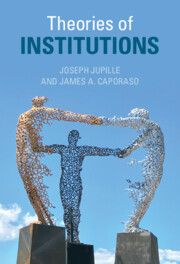Book contents
1 - Introduction
Theories of Institutions
Published online by Cambridge University Press: 06 January 2022
Summary
The human condition teems with institutions, yet scholarly attention ebbs and flows, and scientific progress proceeds unevenly. After almost half a century of “new institutionalisms,” the time has come to take stock of the vast literature, and to identify existing strengths and new opportunities. Building on dozens of conceptions of institutions from across the social sciences, Theories of Institutions defines them as “intertemporal social arrangements that shape human relations in support of particular values.” By definition, institutions endure and institutions are intersubjective. But they are also consequential, impacting aggregate human welfare and very often shaping distributional outcomes. Setting up key concepts of temporality, sociality, (in)efficiency, and power, on which the heart of the book focuses, the Introduction also articulates a set of common questions around institutional origins, maintenance, and change to be addressed throughout. Such analysis promises to shed new light on the dual nature of institutions as human constructs and human constraints, and to identify promising avenues for interdisciplinary dialogue.
Keywords
- Type
- Chapter
- Information
- Theories of Institutions , pp. 1 - 15Publisher: Cambridge University PressPrint publication year: 2022

